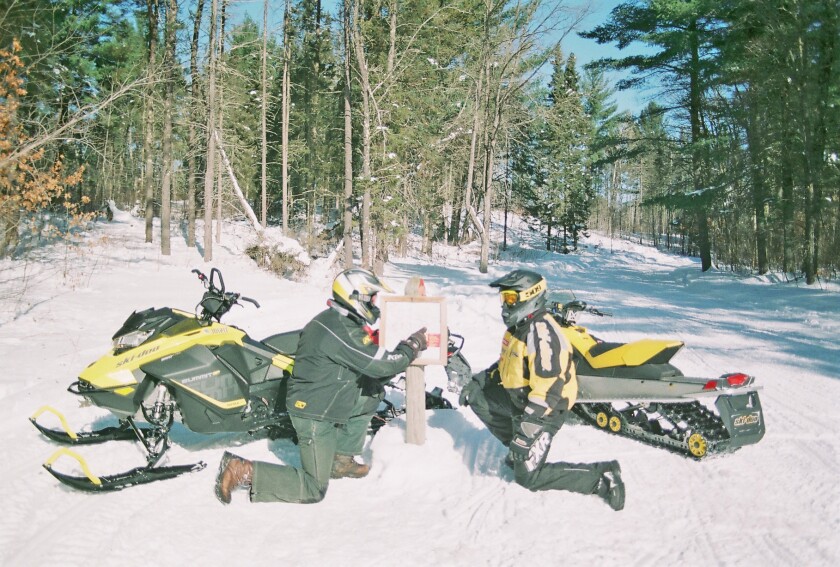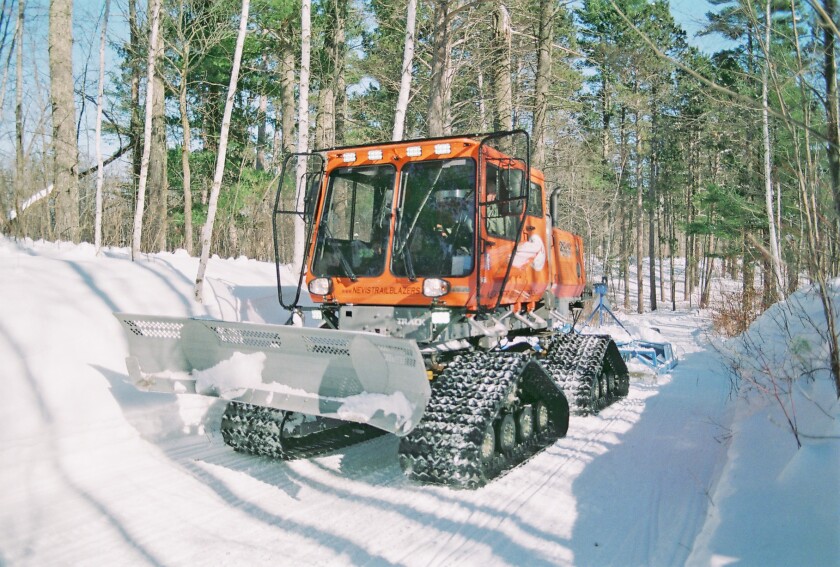PARK RAPIDS, Minn. -- Snowmobiling is a big deal for northern Minnesota – or at least, it will be if the area sees enough snowfall this winter.
Snowmobilers say the weather is only one of several issues affecting the enjoyment of the sport.
ADVERTISEMENT
Butch De La Hunt, president and CEO of the Park Rapids Lakes Area Chamber of Commerce, is a snowmobiler and member of the Forest Riders Snowmobile Club. It is, perhaps, unsurprising that he sees a connection between the sport and its impact on communities.
“Snowmobiling is very important to our tourism industry here in Park Rapids,” De La Hunt said. “It’s part of our heritage. We’ve got a snowmobile race. We’ve got beautiful trails. We have a significant amount of tax-forfeited land that a lot of our trail systems reside in.”
To take best advantage of the trails’ popularity with recreational visitors, he said, cities and snowmobile clubs around Park Rapids have been strategizing to create “feeder trails” routing snowmobilers into town. In addition to the Forest Riders, other snowmobile clubs in the area include the Nevis Trailblazers and the Wolf Pack.
“We’re fortunate that the Heartland Trail comes through the heart of many of our communities,” De La Hunt said, mentioning Nevis and Dorset. “But as you get into certain parts of the city, (we’re) making sure there’s a feeder route that they can get to the Heartland Trail access and all the other trails in the future.”
It also helps that the Heartland Trail, in turn, feeds into other trail systems, including the Paul Bunyan State Forest, he said.

ADVERTISEMENT
Trail maintenance
Club president Richard Ohm said a key focus of the Forest Riders is the “constant maintenance of the existing trails, and sometimes reroutes and reconstructions of the trails” due to natural and man-made wear and tear.
“Our focus has really been on creating and providing safe, rideable trails for the community and for our visitors,” he said.
RELATED STORIES:
Natural things, like beaver dams, influence the trails by causing them to flood and erode away, he said, while ATVs and other vehicles can leave ruts and tear up approaches on multi-use trails.
Ohm said the club paid to have several approaches regraveled and repaired in October. “Those approaches were kind of destroyed from ATVs. But it’s also our snowmobile trail, and we want to be good neighbors to the adjacent landowners, and we want to make it good for our trail.”
The clubs also invest time and effort in clearing brush, maintaining signage and grooming snow on the trails, notably after the Heartland 200 cross-country snowmobile race, “so that our trail riders still have good trails after that race goes through,” Ohm said.
ADVERTISEMENT
Re-routing legwork
Another big part of maintaining a trail system, Ohm said, involves getting permission to cross different landowners’ property.
“Landowners are changing,” he said. “That can really present challenges, when you have new land acquired, and maybe the new landowners are not in favor of motorized use. Over the years, we’ve really tried to keep our trails more on public land, to eliminate some of those issues. So, a lot of it was on county tax-forfeited, state land, or right of ways. Or, we did have, and we still have a fair amount, on Potlatch.”
PotlatchDeltic Corp. recently sold 72,440 acres of timberland in northern Minnesota to The Conservation Fund, with the announced purpose of preserving it for wildlife habitat, public recreation, sustainable timbering and groundwater protection.
Ohm said the announcement made him a little nervous, “but in some of our further research, I’m thinking it could be a really good thing for the area.”
Having to reroute a trail when a new landowner withdraws permission to cross their property involves “a ton of legwork,” he said, from DNR permits to cutting trails through old-growth forest.
“A lot of times, when we have to do these reroutes, we’ve been forced to use public right of way, and that is our least favorite option,” he said.
He explained that running the trail along a right of way increases the risk to snowmobilers and groomers by putting them closer to roadway traffic. “So, if we can at all stay out of public right of way, we’re going to try,” said Ohm, and so the club’s goal is “to keep the trails in the woods, where it’s more enjoyable for riders, and I feel we can provide a safer riding environment.”
ADVERTISEMENT

In-town routes
For several years now, members of the Forest Riders club have been working with the city and the Chamber to develop trail connections within Park Rapids, to give trail users better access to amenities such as restaurants, gas stations and motels.
“I think people are starting to recognize that snowmobiling is a huge economic boom to the community,” said Ohm. “People, when they come up to snowmobile, spend a fair amount on fuel, on lodging and meals. It would not be unrealistic for a family of four to spend $1,000 in Park Rapids for a weekend of snowmobiling. That’s fairly significant.”
Ohm credited Park Rapids City Planner Andrew Mack with encouraging plans for long-term trails within the city, which he hopes will encourage visiting snowmobilers to stop here.
“We’ve created some additional trails in Park Rapids,” said Ohm, “one of the last ones being the trail that loops around the southeast side.”
ADVERTISEMENT
Meanwhile, they’re also working on a spur trail to the Chamber’s wayside rest, where snowmobilers could park, unload their machines and head out for a day on the trail. Ohm said they are still hammering out details such as insurance coverages.
He also shared excitement about the Itasca-Heartland Connection Trail, a multi-use route designed to cut across forested land between County Road 4 and Itasca State Park, with a tunnel under U.S. Hwy. 71. The state Legislature recently approved a bond for the first phase of the project.
Let it snow
“Probably the largest issue for anybody (who makes) an investment to market and build a tourism industry around snowmobiling,” De La Hunt said, “one of the single largest things that has to happen each and every year, is whether you get snow or not.”
While snow is scarce across the state -- as of Wednesday, Dec. 2, the next snowfall that Accuweather forecasts for Park Rapids is expected Dec. 20-22 -- the prospects for a trail run before Christmas in doubt.









